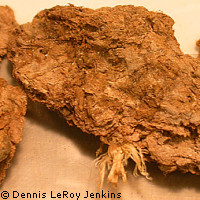New findings put back date of first arrivals in Americas
Fossilised human faeces found in an Oregon cave are forcing archaeologists to rethink the timing of the arrival of the first humans in the Americas. The ancient excrement has been dated to over 14,000 years old, suggesting that immigration took place some 1,000 years earlier than previously believed. The work, which was partly funded by the EU, is published online by the journal Science. The faeces under investigation were found in the Paisley Caves in the western US state of Oregon. The extremely dry conditions in the caves meant that a range of materials, including threads made of sinew and plant fibres, hide, basketry, cords, rope and wooden pegs, as well as animal bones and human and animal faeces, were preserved for millennia. 'We found a little pit in the bottom of a cave,' explains Dr Dennis Jenkins of the University of Oregon, who led the field expeditions at the caves. 'It was full of camel, horse and mountain sheep bones, and in there we found a human coprolite.' DNA tests confirmed that 14 of the coprolites (dried-out excrement) were human, and came from Native Americans with genetic ties to Siberia or Asia. Carbon dating revealed that the oldest coprolites were approximately 14,340 years old. According to the researchers, this not only proves that the American Indians are the descendants of the first immigrants to the Americas, it also proves that immigration took place approximately 1,000 years earlier than once thought. Theories abound as to the precise date and arrival route of the first human settlers of the Americas. However, the most accepted theory is that people arrived around 13,000 years ago from Asia via the land bridge that once connected Siberia and Alaska. These people rapidly spread out across the continent. Known as the Clovis culture, they left behind distinctive points and other tools, but little in the way of human remains. It was presumed that the Clovis people made their way south from Alaska along a corridor in the giant glacier that covered North America at that time. That corridor only opened up around 14,000 years ago, so the findings raise new questions about how these ancient people moved south. 'Our findings show that there were people south of the ice cap several hundred years before the ice-free corridor developed,' commented Professor Eske Willerslev of the University of Copenhagen, who led the team responsible for analysing the ancient excrement. 'The first humans either had to walk or sail along the American west coast to get around the ice cap. That is, unless they arrived so long before the last ice age that the land passage wasn't yet blocked by ice.' 'If our DNA evidence and radiocarbon dating hold up on additional coprolites that are now undergoing testing at multiple labs, then we have broken the Clovis sound barrier, if you will,' added Dr Jenkins. 'If you are looking for the first people in North America, you are going to have to step back more than 1,000 years beyond Clovis to find them.' Whether or not the inhabitants of the Paisley caves had any links with the Clovis culture is unclear, as no stone tools were found at the site. This latest evidence from the DNA confirms results from research carried out at the Paisley Caves in the 1930s by University of Oregon anthropologist Luther Cressman. When Dr Cressman's discoveries were reported in 1940, his conclusions were not widely accepted. He died in 1994. 'Cressman was correct about the association of human cultural remains with Pleistocene animals, but it has taken nearly 70 years and the development and application of new scientific methods to prove it,' said Dr Jenkins. 'Had the human coprolites at the Paisley Caves not been analysed for DNA and subjected to rigorous dating methodology, the pre-Clovis age of the artefacts recovered with the megafaunal remains could not have been conclusively proven. In other words, the pre-Clovis-aged component of this site could very well have been missed or dismissed by archaeologists,' he added. EU support for the research came from the EU-funded FORMAPLEX ('The exploitation of formalin fixed tissues for high-throughput genetic analyses: An HIV-1-HLA cointeraction case study') and GENETIME ('An interdisciplinary training site in ancient biomolecules') projects, both of which are financed by Marie Curie Actions under the Sixth Framework Programme (FP6).
Countries
United States



